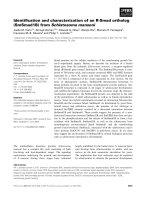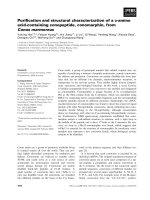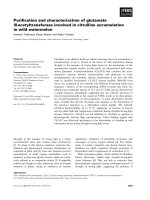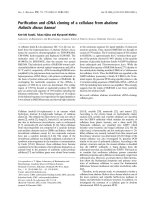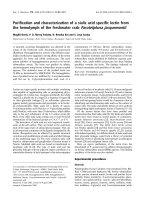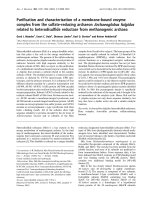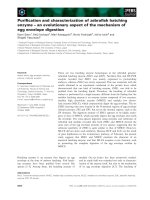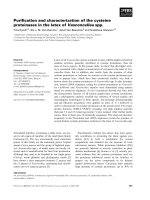Báo cáo khoa học: Purification and characterization of three isoforms of chrysophsin, a novel antimicrobial peptide in the gills of the red sea bream, Chrysophrys major doc
Bạn đang xem bản rút gọn của tài liệu. Xem và tải ngay bản đầy đủ của tài liệu tại đây (649.47 KB, 12 trang )
Eur. J. Biochem. 270, 675–686 (2003) Ó FEBS 2003
doi:10.1046/j.1432-1033.2003.03419.x
Purification and characterization of three isoforms of chrysophsin,
a novel antimicrobial peptide in the gills of the red sea bream,
Chrysophrys major
Noriaki Iijima1, Norio Tanimoto1, Yohko Emoto1, Yohko Morita1, Kazumasa Uematsu2,
Tomoya Murakami3 and Toshihiro Nakai4
1
Laboratory of Molecular Cell Biology, 2Laboratory of Fish Physiology and 4Laboratory of Fish Pathology, Graduate School of
Biosphere Science, Hiroshima University, Japan; 3Hiroshima Fisheries Experimental Station, Ondo, Aki, Japan
We report here the isolation of three isoforms of a novel
C-terminally amidated peptide from the gills of red sea
bream, Chrysophrys (Pagrus) major. Peptide sequences
were determined by a combination of Edman degradation, MS and HPLC analysis of native and synthetic
peptides. Three peptides, named chrysophsin-1, chrysophsin-2, and chrysophsin-3, consist of 25, 25, and 20
amino acids, respectively, and are highly cationic, containing an unusual C-terminal RRRH sequence. The
a-helical structures of the three chrysophsin peptides were
predicted from their secondary structures and were
confirmed by CD spectroscopy. The synthetic peptides
displayed broad-spectrum bactericidal activity against
Gram-negative and Gram-positive bacteria including
Escherichia coli, Bacillus subtilis, and fish and crustacean
pathogens. The three peptides were also hemolytic.
Immunohistochemical analysis showed that chrysophsins
were localized in certain epithelial cells lining the surface
of secondary lamellae and eosinophilic granule cell-like
cells at the base of the secondary lamellae in red sea
bream gills. Their broad ranging bactericidal activities,
combined with their localization in certain cells and
eosinophilic granule cell-like cells in the gills, suggest that
chrysophsins play a significant role in the innate defense
system of red sea bream gills.
Antimicrobial peptides are widely distributed throughout
the animal and plant kingdoms [1]. They display a broad
spectrum of antimicrobial activity against bacteria, yeast
and filamentous fungi, and are recognized as an essential
component in the first line of the host defense system [2,3].
There are three major sites by which bacteria enter fish:
the gills, gastrointestinal tract and skin [4]. Therefore,
antibacterial substances are thought to exist at these sites to
prevent penetration of bacteria into the circulatory system.
In fact, skin mucus, eggs and serum of fish contain a variety
of nonspecific defense substances, such as lysozyme, complement, C-reactive protein, transferrin, lectin, and antimicrobial proteins [5–10]. Furthermore, antimicrobial peptides
have been purified from fish skin mucus: pardaxin from the
moses sole fish Pardachirus marmoratus [11], pleurocidin
from the winter flounder Pleuronectes americanus [12] and
parasin I from the catfish Parasilurus asotus [13], and the
gene expression of pleurocidin-like antimicrobial peptides
found in the skin and intestine of the winter flounder [14].
The antimicrobial peptide, misgurin, has also been purified
from the whole body of the loach Misgurnus anguillicaudatus [15]. These antibacterial peptides show potent
antimicrobial activity against Gram-negative and Grampositive bacteria and act as nonspecific defense substances in
fish skin.
Fish gills are constantly being flushed with water that
may contain fish pathogens, but are covered with only a
thin layer of protective mucus and are constructed of only
a single layer of fragile cells that separate the vascular
system from the external environment. Thus, they are a
very important site of pathogen penetration. Therefore,
potent antimicrobial peptides can be expected to be found
in fish gills to prevent such penetration. However, there is
a paucity of information on nonspecific defense systems in
the gills. An antimicrobial peptide has been identified in
the gills of only one fish species, hybrid striped bass
(Morone saxatilis · M. chrysops) [16–18]. In this study, we
therefore tried to purify antimicrobial peptides from the
gills of the red sea bream Chrysophrys (formerly Pagrus)
major and found that novel antimicrobial peptides,
chrysophsin-1, chrysophsin-2, and chrysophsin-3, are
localized in the eosinophilic granule cell-like cells of the
gills. They exhibited potent bactericidal activity against
Gram-negative and Gram-positive pathogens of fish and
crustaceans.
Correspondence to N. Iijima, Laboratory of Molecular Cell Biology,
Graduate School of Biosphere Science, Hiroshima University,
1-4-4 Kagamiyama, Higashihiroshima 739-8528, Japan.
Fax: + 81 824 22 7059, Tel.: + 81 824 24 7949,
E-mail:
Abbreviations: EGC, eosinophilic granule cell; ESI-ITMS, electrospray ionization/ion trap mass spectrometry; MLC, minimal lethal
concentration; mcKLH, Imject maleimide-activated mariculture
keyhole limpet hemocyanin; NaCl/Pi, 50 mM phosphate buffer
(pH 7.4) containing 0.14 M NaCl; Tris/NaCl, 20 mM Tris/HCl
(pH 7.4) containing 150 mM NaCl.
(Received 2 August 2002, revised 29 November 2002,
accepted 9 December 2002)
Keywords: antimicrobial peptide; chrysophsin; gills; red sea
bream; synthetic peptide.
676 N. Iijima et al. (Eur. J. Biochem. 270)
Ó FEBS 2003
Materials and methods
Chemicals
Fmoc-L-amino acids, Fmoc-L-amino acid resins and
TentaGelÒ S (TGS)-RAM were purchased from Shimadzu
(Kyoto, Japan). Chemicals for peptide synthesis, trifluoroacetic acid, ethylmethylsulfide, ethanedithiol, thiophenol,
2-methylindole, thioanisole, phenol, and anisole were
obtained from commercial sources and were of the highest
purity available. Lysyl endopeptidase, a silver staining II kit
and 2,2,2-trifluoroethanol were purchased from Wako Pure
Chemicals (Tokyo, Japan). A TSKgel G2000SW column
was obtained from Tosoh (Tokyo, Japan), an Inertsil C8-3
column from GL Science (Tokyo, Japan), and a Capcellpak
C18 column from Shiseido (Tokyo, Japan). SP-Sephadex
C-25 was purchased from Pharmacia Biotech (Uppsala,
Sweden), and PolySulfoethyl Aspartamide column was
from Poly LC Inc. (Columbia, MD, USA). Melittin and
BSA were obtained from ICN Biomedicals Inc. (Aurora,
OH, USA), Imject maleimide activated mariculture keyhole
limpet hemocyanin (mcKLH) and Imject Alum were from
Pierce (Rockford, IL, USA), Simple Stain MAX-PO
(Multi) and Simple Stain DAB solution were from Nichirei
(Tokyo, Japan), peroxidase-labeled affinity-purified antibody to rabbit IgG (H + L) was from KPL (Gaithersburg,
MD, USA), DC-protein assay kit was from Bio-Rad
(Hercules, CA, USA), and marine broth 2216 was from
DIFCO (Detroit, MI, USA).
Fig. 1. Flow chart of the purification procedure of antimicrobial peptides
from the gills of red sea bream.
Fish
Red sea bream weighing 1.05–1.14 kg (n ¼ 11) were
cultured by a commercial supplier (Mihara, Hiroshima
Prefecture, Japan). After starvation for 1 day, the fish
were killed by stabbing the brain with a knife, and gill
filaments were immediately collected, frozen in liquid
nitrogen, and stored at )80 °C until use. Red sea bream
weighing 109–305 g (n ¼ 5) were obtained from the
Hiroshima Fisheries experimental station (Ondo, Aki,
Japan). The gill arches including gill lamellae were
immediately fixed in Bouin’s solution and transported
on ice to the laboratory for immunohistochemical examination as described below.
Purification of antimicrobial peptides from the gills
The purification procedure is summarized in Fig. 1.
Frozen gill filaments were crushed in liquid nitrogen.
The resulting gill powder (12 g) was boiled in 120 mL
water for 10 min. After cooling, extractions were performed by adding 120 mL 2 M HCl, 10% (v/v) formic
acid, 2% (w/v) NaCl, and 1% (v/v) trifluoroacetic acid
followed by vortex-mixing for 1–2 min. The homogenate
was centrifuged, and the supernatant adjusted to pH 4 by
adding 1 M Tris; it was then filtered. The resulting filtrate
(219 mL) was used as the acid extract and was applied to
a Sep-Pak C18 cartridge (Waters, Milford, MA, USA).
After a wash with 0.1% trifluoroacetic acid, the peptide
was eluted with 80% acetonitrile/0.1% trifluoroacetic
acid. The dried eluate was dissolved in 1 M acetic acid
and then adsorbed on SP-Sephadex C-25 resin. Successive
elution with 1 M acetic acid, 2 M pyridine and 2 M
pyridine/acetic acid (pH 5.0) afforded three respective
fractions of SP-1, SP-2 and SP-3. The SP-3 fraction was
further lyophilized and dissolved in 40% acetonitrile
containing 0.1% trifluoroacetic acid. An aliquot of the
solution was loaded on a TSKgel G2000SW column
(7.6 · 600 mm) equipped with a Tosoh HPLC pump
(CCPM) and a UV-VIS detector (UV-8010) and was
eluted with 40% acetonitrile containing 0.1% trifluoroacetic acid. The SP-3 fraction was repeatedly injected, and
fraction A, estimated to be less than 5 kDa, was pooled
and subjected to RP-HPLC.
The on-line HPLC separation was performed on a
Hewlett-Packard HP1100 series HPLC system equipped
with an auto sampler, thermostatically controlled column
compartment, UV-VIS detector, and degasser. Solvent A
was 5% acetonitrile containing 0.1% trifluoroacetic acid,
and solvent B was 80% acetonitrile containing 0.085%
trifluoroacetic acid. The freeze-dried fraction A was reconstituted with solvent A and subjected to RP-HPLC on an
Inertsil C8-3 column (4.6 · 150 mm). The gradient was
0–2 min 0% solvent B, 2–5 min 0–20% solvent B, 5–55 min
20–47% solvent B, and 55–80 min 47–100% solvent B. The
effluents were separated into two directions, and the flow
rate of one direction was adjusted to 0.6 mLỈmin)1 and
that of the other to 0.2 mLỈmin)1. The effluent from
one direction (0.6 mLỈmin)1) was fractionated (0.6 mL
each fraction). The effluent from the other direction
Ó FEBS 2003
Three isoforms of chrysophsin in red sea bream gills (Eur. J. Biochem. 270) 677
(0.2 mLỈmin)1) was introduced into a mass spectrometer as
described below. The resulting active fractions were lyophilized and reconstituted in 5 mM KH2PO4/H3PO4 (pH 3.0)
containing 25% acetonitrile, and further loaded on a
PolySulfoethyl Aspartamide column (4.6 · 200 mm)
equipped with a Tosoh HPLC pump. The column was
eluted with a linear gradient of KCl. The gradient was
0–3 min 0–0.1 M KCl, 3–43 min 0.1–0.4 M KCl, and
43–48 min 0.4–1 M KCl.
CA, USA) by analyzing the data calibrated with 10 pmol
phenylthiohydantoin amino-acid standards.
Tricine/SDS/PAGE
The molecular mass of the sample was estimated by Tricine/
SDS/PAGE using a 16.5% separating gel, 10% spacer gel
and 4% stacking gel in the presence of 2-mercaptoethanol
[23], and the protein/peptide bands were stained with a silver
staining II kit from Wako.
Mass spectrometry
Determination of peptide concentration
MS analysis of peptides was performed with a Finnigan
LCQ ion trap mass spectrometer (ThermoQuest, San Jose,
CA, USA) equipped with an electrospray ionization source
(ESI-ITMS) as described previously [19]. The mass scale
was calibrated using Ultra-mark provided by the manufacturer. Ions were detected and analyzed in the positive mode
on the basis of their m/z ratio.
The concentrations of the samples from purification steps
were measured with the DC-protein assay kit using BSA as
standard. The concentration of purified and synthetic
chrysophsin-1 and chrysophsin-2 was obtained from the
A280 [24], and that of chrysophsin-3 with the DC-protein
assay kit.
Solid-phase peptide synthesis
Circular dichroism
The protected peptide chain was assembled with a
Shimadzu peptide synthesizer (PSSM8) according to
standard Fmoc chemistry [20]. Non-amidated peptides
were prepared with Fmoc-L-His (Trt)-resin, and amidated
peptides with TGS-RAM as described previously [21].
Magainin 2 [22] was prepared with Fmoc-L-Ser (tBu)resin, and peptide-Cys, to which cysteine was added at the
carboxy end, was prepared with Fmoc-L-Cys (Trt)-resin.
At the end of the synthesis, the peptides were freed from
the resin by cleavage with cocktail A (82.5% trifluoroacetic acid, 3% ethylmethylsulfide, 5% H2O, 2.5%
ethanedithiol, 3% thiophenol, and 5 mgỈmL)1 2-methylindole) for peptides with Trp and Arg, cocktail B (82%
trifluoroacetic acid, 2% ethylmethylsulfide, 5% H2O, 5%
thioanisole, 3% ethanedithiol, and 2% phenol) for
peptides with Arg, or cocktail C (94% trifluoroacetic
acid, 5% anisole, and 1% ethanedithiol) for peptides
without Arg and Trp. The resulting peptides were
precipitated with cold diethyl ether, lyophilized, and then
purified using a Tosoh HPLC apparatus, equipped with a
Capcellpak C18 column (10 · 250 mm), eluted with a
linear gradient of acetonitrile/0.1% trifluoroacetic acid.
Aliquots of peptides purified by RP-HPLC were characterized with ESI-ITMS as described below.
CD spectra were recorded on a Jasco J-500CH instrument
(Tokyo, Japan) at room temperature in a 1-mm path length
cell. Synthetic crysophsins 1, 2 and 3 were dissolved in
20 mM potassium phosphate buffer (pH 7.25) containing
8 mM EDTA or 20 mM potassium phosphate buffer
(pH 7.25) containing 8 mM EDTA and 50% trifluoroethanol. The concentration of the chrysophsins was 20 lM.
Curves were smoothed by the algorithm provided by Jasco,
and data analysis was performed as described previously
[25]. CD measurements were reported as Q (degreesỈ
cm2Ỉdmol)1). The relative helix content was deduced as
described by McLean et al. [26] as follows.
Lysyl endopeptidase digestion
The three purified peptides, P-1 (2.9 lg), P-2 (0.6 lg) and
P-3 (0.46 lg), dissolved in 20 lL 20 mM Tris/HCl (pH 8.0)
were mixed with lysyl endopeptidase and incubated for
2–4 h at 37 °C. The ratio of enzyme to peptide was 1 : 100
for P-1 and 1 : 5 for P-2 and P-3. After digestion, the
reaction was stopped by adding 0.1% trifluoroacetic acid at
a final volume of 0.1 mL.
Amino-acid sequence analysis
The amino-acid sequence of the three purified peptides, P-1,
P-2 and P-3 (1.5–2.9 lg), was determined on a Hewlett–
Packard G1005A protein sequencing system (Palo Alto,
%helix ¼ À 100H222 ỵ 3000ị=33000
where Q222 is the CD at 222 nm.
Bactericidal assay
Bactericidal activity was routinely tested using Bacillus
subtilis ATCC6633 or Escherichia coli WP-2. After growth
in tryptic soy broth at 37 °C to exponential phase, bacteria
were washed twice with 0.85% NaCl and diluted in 50 mM
Hepes/NaOH buffer (pH 7.4) to give % 2 · 105 colonyforming unitsỈmL)1 (CFmL)1). Aliquots (25–100 lL) of
the fractions at each purification step from the acid extract
of the gills were lyophilized and dissolved in 0.1 mL 1 mM
citric acid/sodium citrate buffer (pH 4.0). Solutions were
mixed with an equal volume of bacterial suspension and
incubated at 37 °C for 60 min. In a control experiment, the
cells were incubated with the same solvent as used for the
preparation of each fraction. After appropriate dilution of
the mixture with 50 mM Hepes/NaOH buffer (pH 7.4),
0.1 mL aliquots were spread on tryptic soy agar plates and
incubated for 14–18 h to measure the number of colonies
formed. The bactericidal activity was expressed as killing
(%), using the formula [27]:
Killing %ị ẳ ẵ1 CFU in the sampleị=
CFU in the control  100
Ó FEBS 2003
678 N. Iijima et al. (Eur. J. Biochem. 270)
Serial doubling dilutions of the three native and synthetic
chrysophsins were carried out following the protocol
described above, and the minimal lethal concentration
(MLC) against E. coli and B. subtilis was defined as the
lowest peptide concentration that caused % 99% killing of
the bacteria [28]. All assays were performed in duplicate.
Fish and crustacean pathogens, Lactococcus garvieae
YT-3, Streptococcus iniae F-8502, Aeromonas hydrophila
ET-4, Edwardsiella tarda ET-82016, Vibrio anguillarum
ATCC 19264, Vibrio vulnificus ET-7617 and Pseudomonas
putida ATCC 12633 were grown in tryptic soy broth at 25 °C,
and Aeromonas salmonicida NCMB 1102 was grown in
tryptic soy broth at 20 °C. Vibrio harveyi HUFP 9111 and
Vibrio penaeicida KH-1 were grown in marine broth 2216 at
25 °C. After growing, exponential phase bacterial cultures
were washed and diluted in 50 mM Hepes/NaOH buffer
(pH 7.4) containing 2% NaCl to give % 2 · 105 CFmL)1.
The bacterial suspensions (each 0.1 mL) were incubated at
20–25 °C for 1 h with equal volumes of twofold serial
dilutions of the three synthetic chrysophsins in 1 mM citric
acid/sodium citrate buffer (pH 4.0) containing 2% NaCl.
After 100-fold dilution of the mixture, 0.1 mL aliquots were
spread on tryptic soy agar plates and incubated at 20–25 °C
for 18–24 h. Then, MLC was determined as described above.
Hemolytic assay
Before use, freshly collected human blood was washed with
50 mM phosphate buffer (pH 7.4) containing 0.14 M NaCl
(NaCl/Pi) until the supernatant was colorless. A suspension
was made of 1% packed cells in NaCl/Pi containing 2%
glucose. Synthetic chrysophsin 1, 2 or 3, melittin or synthetic
magainin 2 was dissolved in 50% dimethyl sulfoxide at a
concentration of 1 mM and was serially diluted with NaCl/
Pi. From this suspension, 90 lL aliquots were incubated
with 10 lL synthetic chrysophsin 1, 2 or 3, melittin or
synthetic magainin 2 at different concentrations. As a
positive control (100% lysis), a 0.1% solution of SDS was
used. After incubation for 30 min at 37 °C, the sample
was centrifuged at 900 g for 10 min. The supernatant was
diluted 20-fold with NaCl/Pi, and the absorbance was
determined at 405 nm in a Shimadzu UV-VIS spectrophotometer (UV mini 1240). To control for dimethyl sulfoxide
in the peptide, erythrocyte suspensions were incubated with
50% dimethyl sulfoxide.
was determined by ELISA using chrysophsin-1-Cys as an
antigen and peroxidase-labeled affinity-purified antibody to
rabbit IgG (H + L) as a secondary antibody.
Chrysophsin-1-Toyopearl was used for the purification of
anti-(chrysophsin-1) IgG. Chrysophsin-1-Cys (1 mg) was
coupled to Toyoperal AF-Epoxy-650M (1 g) according to
the manufacturer’s protocol. Anti-(chrysophsin-1) serum
(3 mL) was filtered through a 0.45-lm filter (Dismic-13,
Advantec, Tokyo, Japan) and applied to the chrysophsin1-Toyopearl column. The column was washed with 20 mM
Tris/HCl (pH 7.4) containing 150 mM NaCl (Tris/NaCl)
and 20 mM Tris/HCl (pH 7.5) containing 1 M NaCl and
1% Triton X-100, respectively, and specific antibody was
eluted from the column with 0.1 M glycine/HCl (pH 2.5).
The eluted antibody was immediately neutralized with 1 M
Tris and stored at )80 °C.
Immunohistochemistry
Gill arches were fixed in Bouin’s solution for 24 h at room
temperature. After dehydration, tissues were embedded in
paraffin, cut into 5-lm sections, and mounted on gelatincoated glass slides. Immunohistochemical staining was
performed using Simple Stain MAX-PO (Multi) as a
secondary antibody [29]. Briefly, sections were deparaffinized in xylene and rehydrated in decreasing concentrations
of ethanol. After a brief wash with NaCl/Pi, sections were
exposed to 3% H2O2 in 90% methanol to block endogenous
peroxidase and washed with NaCl/Pi. They were then
blocked with 10% normal goat serum in NaCl/Pi for 2 h at
room temperature, incubated with the chrysophsin-1-specific antibody (0.11 lgỈmL)1) in NaCl/Pi containing 1% BSA
and 5 mM NaN3 overnight at room temperature, and
washed 3 times with NaCl/Pi. The sections were incubated
with the secondary antibody for 30 min at room temperature and washed with NaCl/Pi. The color was developed in a
Simple Stain DAB solution. To determine the type of
immunoreactive cells in the gills, neighboring 5-lm serial
sections of the gills were stained with chrysophsin-1-specific
antibody or hematoxylin and eosin. As a negative control,
chrysophsin-1-specific antibody preabsorbed with chrysophsin-1 (mol ratio of antibody to chrysophsin-1 ¼
1 : 5000) was used as a primary antibody.
Results
Preparation of anti-(chrysophsin 1) IgG
Peptide purification and primary structure
Synthetic chrysophsin-1-Cys (2.3 mg) purified by
RP-HPLC was dissolved in 60% dimethyl sulfoxide and
conjugated with 2.3 mg mcKLH according to the manufacturer’s directions. The resulting chrysophsin-1-CysmcKLH conjugate (chrysophsin-1-KLH) was dialyzed
against NaCl/Pi and used as described below. For initial
immunization, 600 lg chrysophsin-1-KLH in 500 lL
NaCl/Pi was mixed with an equal volume of Imject Alum
and administered to Japanese white rabbits by multiple
subcutaneous injections. Ten, 21 and 33 days later, the
rabbit received 600 lg chrysophsin-1-KLH in 500 lL
NaCl/Pi by subcutaneous injection. At 4 days after the
final injection, blood was collected, and the resulting
antiserum was stored at )80 °C. The titer of the antisera
After fractionation of the acid-extracted gill powder on SPsephadex C-25, fraction SP-3 showed the most bactericidal
activity (MLC 1.2 lgỈmL)1) and was further separated by
gel-filtration HPLC (Fig. 2). Bactericidal activities against
B. subtilis were detected in almost all of the fractions eluted
from the column. The molecular mass of fractions eluted
between 48 and 81min, showing high antibacterial activity,
was determined by Tricine/SDS/PAGE. As this study
focuses exclusively on bactericidal peptides of less than
5 kDa which were mainly detected in fraction A (data not
shown), it was subjected to RP-HPLC followed by ESIITMS (Fig. 3). The deduced mean ± SD molecular masses
of the three peaks, P1, P2 and P3, showing strong
bactericidal activity were 2891.2 ± 0.2, 2919.3 ± 0.4 and
Ó FEBS 2003
Three isoforms of chrysophsin in red sea bream gills (Eur. J. Biochem. 270) 679
Fig. 2. Gel-filtration HPLC of the SP-3 fraction obtained from the acid
extract of red sea bream gills. The SP-3 fraction eluted with 2 M pyridine/acetic acid (pH 5.0) from SP-sephadex C-25 was loaded on a
TSKgel G2000SW column pre-equilibrated with 40% acetonitrile/
0.1% trifluoroacetic acid. The flow rate was 0.25 mLỈmin)1, and
absorbance was monitored at 220 nm (solid line). The fraction volume
was 0.5 mL. The bactericidal activity against B. subtilis of a 100-lL
aliquot of each fraction was measured and expressed as killing (%)
(open bar) as described in Materials and methods. Fraction A, indicated by the bar, was collected.
2285.7 ± 0.2 Da, respectively. By RP-HPLC, P1, P2 and
P3 were pooled. As a broad but single band was observed by
Tricine/SDS/PAGE (data not shown), aliquots of P1, P2
and P3 were directly sequenced by Edman degradation.
The amino-acid sequences were then partially determined
(Table 1). As the underlined residues could not be determined, they were digested with lysyl endopeptidase, and the
resulting peptide fragments subjected to RP-HPLC followed by ESI-ITMS. From the difference between the
deduced mean molecular mass of the peptide fragment by
ESI-ITMS and the theoretical mean molecular mass of the
identified amino-acid sequence of the peptide fragment, the
unidentified amino acid was determined as His. For
example, three peptide fragments, (1) FFGWLIK, (2)
GAIXAGK, and (3) AIXGLIXRRRX, were released from
P1 by lysyl endopeptidase. The mean molecular mass
(909.6 ± 0.2 Da) of fragment 1 determined by ESI-ITMS
was very similar to that of fragment 1 calculated from the
identified amino-acid sequence (910.10 Da). The difference
in the mean molecular mass of fragment 2 determined by
ESI-ITMS (652.5 ± 0.0 Da) and that of fragment 2
calculated from the identified amino-acid sequence
(515.61 Da) was 137.1 Da, which agreed with the average
molecular mass of His (Table 1). On replacing the unknown
amino acids of fragment 3 with His, the theoretical average
molecular mass (1365.62 Da) of fragment 3 calculated from
the amino-acid sequence was almost the same as that of
fragment 3 deduced by ESI-ITMS (1364.8 Da). Finally,
amino-acid sequences of P1, P2 and P3 were determined as
follows. P1, FFGWLIKGAIHAGKAIHGLIHRRRH;
P2, FFGWLIRGAIHAGKAIHGLIHRRRH; P3, FIG
LLISAGKAIHDLIRRRH. The theoretical average
molecular masses of P1 (2892.43 Da), P2 (2920.45 Da)
and P3 (2286.76 Da) matched the deduced average molecular masses with a difference of 1 Da. This discrepancy
(1 Da) suggests amidation of the C-terminal histidine.
Therefore, elution profiles of synthetic nonamidated peptides named P1-COOH, P2-COOH and P3-COOH, and
synthetic amidated peptides named P1-CONH2,
P2-CONH2 and P3-CONH2 were superimposed on
those of native P1, P2 and P3 by HPLC. Native P1 and
P3 were recognized as single peaks by RP-HPLC (data not
shown) and also by anion-exchange HPLC (Fig. 4A,C).
P1-COOH and P1-CONH2 could not be separated by
RP-HPLC; however, they were clearly separated into
two peaks at retention times of 18 and 22 min (Fig. 5A),
and the mixture of native P1and P1-CONH2 showed a
single peak on ion-exchange HPLC (Fig. 5B). Thus, the
C-terminal amino acid His of native P1 was found to be
Fig. 3. RP-HPLC of fraction A obtained by gel-filtration HPLC. Fraction A obtained by gel-filtration HPLC was loaded on an Inertsil C8-3
column and eluted with a linear gradient of acetonitrile in aqueous trifluoroacetic acid (dotted line). The flow rate was 0.8 mLỈmin)1, and the
absorbance was monitored at 220 nm (solid line). The effluent was separated into two directions, and the effluent from one direction was collected.
The bactericidal activity of each fraction was expressed as killing (%) (open bar) as described in Materials and methods. The effluent from the other
direction was directly introduced into an electrospray ionization/mass spectrometer (ESI/ITMS).
Ó FEBS 2003
680 N. Iijima et al. (Eur. J. Biochem. 270)
Table 1. Mass measurement of peptide fragments of P1, P2 and P3.
Partial sequence
PI
ESI-ITMS
Mr
FFGWLIKGAIXAGKAIXGLIXRRRX
2891.2
P2
FFGWLIRGAIXAGKAIXGLIXRRRX
2919.3
P3
FIGLLISAGKAIXDLIRRRX
2285.7
Peptide fragment
ESI-ITMS
Mr
Calc.
Mr
His (·)
FFGWLIK
GAIXAGK
AIXGLIXRRRX
FFGWLIRGAIXAGK
AIXGLIXRRRX
FIGLLISAGK
AIXDLIRRRX
909.6
652.5
1364.8
1573.0
1364.8
1017.8
1285.3
910.10
515.61
954.20
1435.71
954.20
1018.26
1012.24
137.1
3 ·137.1
137.1
3 ·137.1
–
2 · 137.1
P2-1 fraction. From these results, the primary structures of
three novel bactericidal peptides, P1, P2-2 and P3, were
determined, and we decided to call them chrysophsin-1,
chrysophsin-2 and chrysophsin-3 based on the genus of red
sea bream, C. major. An alignment of these three peptides
with other antimicrobial peptides is shown in Fig. 6.
Chrysophsin-1, chrysophsin-2 and chrysophsin-3 are
C-terminally amidated, 25, 25 and 20 amino acids in length,
and rich in cationic residues (9/25, 9/25 and 6/20, respectively). Chrysophsin-2 corresponds to the chrysophsin-1
isoform differing by a single residue at position 7 (lysine or
arginine). Interestingly, the characteristic C-terminal cationic tetrapeptide, RRRH, is conserved in chrysophsins, in
addition to the C-terminal amidation.
Secondary structure of chrysophsins
Fig. 4. Cation-exchange HPLC of P1, P2 and P3. Aliquots of P1 (A),
P2 (B) and P3 (C) were loaded on a PolySulfoethyl Aspartamide column and eluted with a linear gradient of KCl in 5 mM KH2PO4/H3PO4
(pH 3.0)/25% acetonitrile at a flow rate of 0.8 mLỈmin)1 (dotted line).
Absorbance was monitored at 220 nm (solid line).
amidated. Native P3 was also found to be amidated
(Figs 4C and 5F). Native P2 was detected as a single peak
by RP-HPLC (data not shown). However, native P2
separated into two peaks, P2-1 and P2-2 (Fig. 4B), and
P2-2 was coeluted with P2-CONH2 on anion-exchange
HPLC (Fig. 5C,D). P2-1 and P2-2 were separated by anionexchange HPLC and further analyzed by RP-HPLC
followed by ESI-ITMS. As the mean molecular mass of
P2-2 (2919.3 ± 0.4 Da) was identical with that of P2CONH2, P2-2 was also an amidated peptide. Two peptides,
2925 ± 0.7 Da and 2907 ± 0.3 Da, were detected in the
Schiffer–Edmunson helical wheel modeling was used to
predict hydrophobic and hydrophilic regions within the
secondary structure of chrysophsin-1, chrysophsin-2 and
chrysophsin-3 (Fig. 7). All three had an amphipathic
a-helix conformation, indicating hydrophilic and hydrophobic residues on opposite sides of the N-terminal 21
residues for chrysophsin-1 and chrysophsin-2, and 18
residues for chrysophsin-3. This conformation was confirmed by CD spectroscopy of the three synthetic chrysophsin peptides in the absence or presence of 50%
trifluoroethanol (Fig. 8). In the absence of 50% trifluoroethanol, the spectra of all three chrysophsins are typical
of a disordered structure. However, their ellipiticities
decreased at both 208 and 222 nm and increased at
190 nm, indicating stabilization of the a-helix structure
(87%, 88% and 81% helix content in chrysophsin-1,
chrysophsin-2 and chrysophsin-3, respectively) in the
presence of 50% trifluoroethanol.
Bactericidal spectrum, salt sensitivity
and hemolytic activity of chrysophsins
As the bactericidal activities of the three native and synthetic
chrysophsins were found to be almost equal against
B. subtilis and E. coli (Table 2), bactericidal activity
against fish and crustacean pathogens was investigated with
the synthetic chrysophsins (Table 3). All three were
active against Gram-positive bacteria (MLC < 10 lM).
Most of the Gram-negative pathogens were sensitive to
less than 40 lM, except for A. hydrophila and E. tarda
Ó FEBS 2003
Three isoforms of chrysophsin in red sea bream gills (Eur. J. Biochem. 270) 681
Fig. 5. Cation-exchange HPLC of native P1, P2-2 and P3, and their synthetic peptides. Mixtures of synthetic P1-COOH and P1-CONH2 (A), native
P1 and P1-CONH2 (B), P2-COOH and P2-CONH2 (C), native P2 and P2-CONH2 (D), P3-COOH and P3-CONH2 (E), and native P3 and
P3-CONH2 (F) were loaded on a PolySulfoethyl Aspartamide column and eluted with a linear gradient of KCl in 5 mM KH2PO4/H3PO4 (pH 3.0)
containing 25% acetonitrile at a flow rate of 0.8 mLỈmin)1 (dotted line). Absorbance was monitored at 220 nm (solid line).
Fig. 6. Comparison of the amino-acid sequence of the chrysophsins with other antimicrobial peptides. Alignment of the mature amino-acid sequences
of chrysophsin-1, chrysophsin-2 and chrysophsin-3, misgurin [15], pleurocidin [12] and pleurocidin-like antimicrobial peptides/WF2-4 [14], piscidin
1 (sb-moronecidin), 2 (wb-moronecidin) and 3 [16,17] and melittin [22]. Gaps have been introduced to maximize sequence similarities. Identical
amino-acid residues are shaded, and basic amino-acid residues are shown in bold.
(MLC > 40 lM). P. putida was sensitive to chrysophsin-1
and chrysophsin-3, but not to chrysophsin-2
(MLC > 40 lM).
To determine whether the bactericidal action of chrysophsins is dependent on salt, NaCl concentration was
varied with the chrysophsin concentration kept fixed
(Fig. 9). Chrysophsin-1 and chrysophsin-2 were bactericidal
up to 0.32 M NaCl, but chrysophsin-3 was effective only up
to 0.16 M NaCl.
Chrysophsins were hemolytic for human red blood cells,
but they were less hemolytic than melittin and more
hemolytic than magainin (Fig. 10).
Ó FEBS 2003
682 N. Iijima et al. (Eur. J. Biochem. 270)
Fig. 7. Schiffer–Edmunson helical wheel diagram demonstrating probable amphipathic a-helical conformation of chrysophsin-1, chrysophsin-2 and
chrysophsin-3. Shaded gray indicates hydrophobic amino acids. Residue numbers starting from the N-terminus are shown.
Localization of chrysophsin-1 in the gills of red sea
bream
Immunohistochemical staining showed that chrysophsin-1
was localized in the gills of red sea bream as two distinct cell
populations. The first type of immunopositive cells were
found at the base of the secondary lamellae (Fig. 11A,
arrows in Fig. 11C and Fig. 11G), and were located
adjacent to the blood capillaries in the connective tissue
(Fig. 11D,H). In the immunopositive cells, cytoplasmic
granules were immunostained (arrows in Fig. 11E,I) and
were eosinophilic in nature (arrows in Fig. 11F). The second
type of immunoreactive cell was an epithelial cell on the
secondary lamellae (Fig. 11A and arrowheads in Fig. 11C).
No immunoreactivity was observed in any sections stained
with chrysophsin-1-specific antibody preabsorbed with
chrysophsin-1 (Fig. 11B).
Discussion
Here we report the isolation of chrysophsin-1, chrysophsin-2 and chrysophsin-3, novel peptides of 25, 25 and
20 residues with bactericidal and hemolytic activity, from
the gills of the red sea bream, C. major. They are highly
Ó FEBS 2003
Three isoforms of chrysophsin in red sea bream gills (Eur. J. Biochem. 270) 683
Fig. 8. CD spectrum for synthetic chrysophsins. The spectra of synthetic chrysophsin-1 (A), chrysophsin-2 (B) and chrysophsin-3 (C)
were obtained in 20 mM potassium phosphate buffer/8 mM EDTA,
pH 7.25, in the presence (solid line) or absence (dotted line) of 50%
(v/v) trifluoroethanol.
cationic peptides without cysteine (Fig. 6). Searches of
sequence databases show 70% identity between chrysophsin-1 and the mature peptide sequence predicted from
the nucleotide sequence of winter flounder pleurocidin-like
genomic clone (WF3), which has not yet been purified as
a mature peptide [14]. However, chrysophsin-1 shows low
identity (24–36%) with other fish antimicrobial peptides,
such as piscidins [16], moronecidins [17] and pleurocidin
[12,30]. The C-terminal amino acid was amidated in all
three chrysophsins, similarly to those in marine animals,
such as solitary ascidians (styelin D) [31] and hybrid
striped bass (Morone saxatilis x M. chrysops) (moronecidin/piscidin) [16,17]. It has been proposed that amphipathic a-helical peptides show antimicrobial activity by
interacting electrostatically with the anionic bacterial
membrane, adopting an amphipathic a-helical conformation that allows them to insert the hydrophobic face into
the lipid bilayers and form a pore [1,8,22]. The amphipathic a-helical structure of chrysophsins was predicted by
the Schiffer–Edmundson wheel analysis (Fig. 7). All three
chrysophsins form an a-helical structure (> 80% helical
content) in the structure-forming solvent, trifluoroethanol,
but not in phosphate buffer (Fig. 8). This suggests that
random-coiled chrysophsins in the water environment will
form amphipathic a-helical conformation after contacting
with the bacterial membrane. Thus, chrysophsins will
show antimicrobial activity in a similar way to other
previously studied amphipathic a-helical antimicrobial
peptides. Interestingly, the identity in amino-acid sequence
between chrysophsin and misgurin is low (16%), but
chrysophsins and misgurin have strongly cationic tetrapeptide sequences, RRRH and RRRK, at the C-terminus.
Bee venom melittin also has a C-terminal cationic
tetrapeptide sequence, KRKRQQ, and was found to
form a nonhelical hydrophilic domain that allows electrostatic binding with the polar head group of negatively
charged phospholipids [32–34]. Thus, the C-terminal
RRRH of chrysophsins could form a nonhelical hydrophilic domain similarly to bee venom melittin.
All three chrysophsins showed bactericidal activity
against Gram-negative and Gram-positive pathogens in
the presence of 0.34 M NaCl, except for A. hydrophila and
E. tarda. The results indicate that chrysophsins show
broad-spectrum bactericidal activity against pathogenic
bacteria up to 0.34 M NaCl. The bactericidal activity of
chrysophsin-1 and chrysophsin-2 at a concentration of
0.5 lM was retained at physiological NaCl concentrations
against E. coli, but was lost at 0.64 M NaCl, similarly to
winter flounder pleurocidin: the bactericidal activity of
pleurocidin (5.6 lM) against E. coli was also lost at
0.625 M NaCl [12]. On the other hand, hybrid striped
bass wb-moronecidin retained bacteriostatic activity
against Staphylococcus aureus even in the presence of
1.28 M NaCl; however, it remains unclear whether
wb-moronecidin is bactericidal or not in 1.28 M NaCl
[17]. The net charge of chrysophsin-1 (pI 12.64) and
chrysophsin-2 (pI 12.79) is slightly higher than that of
wb-moronecidin (piscidin 2) (pI 12.60). In addition, the
C-terminal amino acids of chrysophsins and wb-moronecidin were both amidated. These findings may indicate
that the difference in salt tolerance between chrysophsins
and wb-moronecidin is partly due to the difference in
bacteria, Gram-negative E. coli and Gram-positive
S. aureus used in the experiment. Antimicrobial peptides
must pass the lipopolysaccharide-rich external leaflet of
the outer membrane to interact with the inner membrane
of Gram-negative bacteria such as E. coli; however, they
can directly interact with the anionic cytoplasmic membrane of Gram-positive bacteria such as S. aureus. It is
necessary to compare the bacteriostatic and bactericidal
activities of chrysophsins against Gram-positive bacteria,
Ó FEBS 2003
684 N. Iijima et al. (Eur. J. Biochem. 270)
Table 2. Bactericidal activity (minimal lethal concentration) of native and synthetic chrysophsins compared with that of magainin-2. Minimal lethal
concentrations of peptide are given in lM and are the concentration of substance required necessary to kill % 99% of the bacteria.
Chrysophsin-1
Chrysophsin-2
Chrysophsin-3
Strains of bacteria
Native
Synthetic
Native
Synthetic
Native
Synthetic
Magainin2
Bacillus subtilis ATCC 6633
Escherichia coli WT-2
0.25
0.25
0.125
0.25
0.25
0.25
0.25
0.25
0.25
0.25
0.25
0.25
0.985
0.985
Table 3. Bactericidal activity (minimal lethal concentration) of synthetic chrysophsin-1, -2 and -3 against pathogenic bacteria. Minimal lethal concentrations of peptide are given in lM and are the concentration of substance required necessary to kill % 99% of the bacteria. Strains were
considered resistant (R) when their growth was not inhibited by peptide up to 40 lM.
Strains of pathogenic bacteria
Gram-positive bacteria
Lactococcus garvieae YT-3(ATCC 49156)
Streptococcus iniae F-8502
Grain-negative bacteria
Vibrio anguillarum ATCC 19264
Vibriopenaeicida KHA
Vibrio harveyi HUFP911 1 (ATCC 14126)
Vibrio vulnificus ET-7617(ATCC 33148)
Aeromonas hydrophila ET-4
Aeromonas salmonicida NCMB 1102
Pseudomonas putida ATCC 12633
Edwardsiella tarda ET-82016
Chrysophsin-1
Chrysophsin-2
Chrysophsin-3
10
2.5
5
1.5
10
10
2.5
10
2.5
5
R
10
40
R
1.25
5
5
2.5
R
5
R
R
10
10
5
10
R
10
40
R
in addition to the Gram-negative bacteria. Chrysophsins
showed hemolytic activity against human erythrocytes, in
addition to bactericidal activity (Fig. 10); however, they
are less hemolytic than melittin, a cytotoxic peptide, but
more hemolytic than magainin. It is still necessary to
examine whether chrysophsins are cytotoxic to the gill
cells of red sea bream or not. Chrysophsin-3 was the least
hemolytic and bactericidal. This may correlate with the
lower isoelectric point (pI 12.16) than that of chrysophsin-1
and chrysophsin-2.
We used polyclonal antibody against chrysophsin-1 as a
primary antibody for immunohistochemistry (Fig. 11).
Fig. 9. Effect of NaCl on bactericidal activity of chrysophsins. Bactericidal activity of synthetic chrysophsin-1 (s), chrysophsin-2 (h) and
chrysophsin-3 (n) at 0.5 lM was determined with various concentrations of NaCl ranging from 0 to 1.28 M.
Fig. 10. Hemolytic activity of chrysophsins. Synthetic chrysophsin-1
(s), chrysophsin-2 (h) and chrysophsin-3 (n), synthetic magainin 2
(j), an antimicrobial peptide from the aquatic frog Xenopus laevis and
melittin (d), a peptide from bee venom cytotoxic to human erythrocytes, were incubated with a 1% suspension of washed human erythrocytes for 30 min at 37 °C.
Ó FEBS 2003
Three isoforms of chrysophsin in red sea bream gills (Eur. J. Biochem. 270) 685
cells appeared to have eosinophilic granules in the
cytoplasm (Fig. 11F). Eosinophilic granule cells (EGCs)
were located in the connective tissues of the primary
lamellae of fish gills, in close association with blood vessels
[35]. Piscidins have been reported in the mast cells of gills
of a hybrid striped bass [16], but it is not known whether
histamine is released or whehter they possess other
characteristics of mast cells [35]. Thus, we assume that
the immunopositive cells located in the connective tissue at
the base of secondary lamellae are EGCs. Chrysophsins
also accumulated in some cells of the secondary lamellae,
located on the surface of gill tissue (Fig. 11C). Piscidins
were very recently found to localize in the mast cells of
gills, not in epithelial cells [16]. Teleost gill epithelia line the
external boundary and consist mainly of pavement,
mucous and chloride cells [36], and the pavement cells
constitute more than 80% of gill epithelium [37]. It
remains unclear whether chrysophsins localize in the
epithelial cells, such as mucous and chloride cells, of
the secondary lamellae or in EGCs that have infiltrated
the epithelium. Future work is required to ascertain the
exact cell-type that produces chrysophsins.
It remains unclear which chrysophsin isoforms exist in
certain cells of secondary lamellae and EGC-like cells of the
primary lamellae of red sea bream gills. We are currently
trying to obtain cDNAs encoding chrysophsins from the
gills of red sea bream, and we aim to investigate the gene
expression of the chrysophsin isoforms in these cells by
in situ hybridization.
Acknowledgements
We thank Dr S. Ohta (Instrument Center for Chemical Analysis,
Hiroshima University) and Professor K. Gekko (Graduate School of
Science, Hiroshima University) for the CD analysis. This work was
supported in part by a grant-in-aid from the Ministry of Education,
Science, Sports, and Culture of Japan.
References
Fig. 11. Immunohistochemical localization of chrysophsins in the gills of
the red sea bream. Adjacent sections in the gills were immunostained
with chrysophsin-1 antibody (A, C, E and F) and with hematoxylin
and eosin (D, F and H) as described in Materials and Methods.
Immunopositive cells were mainly observed among connective tissues
at the base of the secondary lamella (A, arrows in C, G and I) and
epithelial cells on the secondary lamella (A and arrowheads in C).
Enlargement of sections C, D and G are shown in sections E, F and I,
respectively. No immunoreactivity was observed with chrysophsin-1
antibody preabsorbed with chrysophsin-1 (B). Calibration bars:
A–D,G and H, 50 lm; E, F and I, 10 lm.
The amino-acid sequences of chrysophsin-1 and chrysophsin-3 was % 80% identical, and the sequences of chrysophsin-1 and chrysophsin-2 differ by only one residue at
position 7 (Fig. 6). Thus it is probable that chrysophsin-1specific antibody also reacts with chrysophsin-2 and
chrysophsin-3. Chrysophsins accumulate in the cells at
the base of the secondary lamellae (Fig. 11A,C), especially
in the cytoplasmic granules of the cells (Fig. 11E,I). The
1. Zasloff, M. (2002) Antimicrobial peptides of multicellular organisms. Nature (London) 415, 389–395.
2. Hancock, R.E. & Scott, M.G. (2000) The role of antimicrobial
peptides in animal defenses. Proc. Natl. Acad. Sci. USA 97, 8856–
8861.
3. Hancock, R.E. & Diamond, G. (2000) The role of cationic antimicrobial peptides in innate host defences. Trends Microbiol. 8,
402–410.
4. Evelyn, T.P.T. (1996) Infection and disease. In The Fish Immune
System: Organism, Pathogen, and Environment (Iwama, G. &
Nakanishi, T., eds), pp. 339–366. Academic Press, Inc, San Diego.
5. Yano, T. (1996) The nonspecific immune system: humoral defense.
In The Fish Immune System: Organism, Pathogen, and Environment (Iwama, G. & Nakanishi, T., eds), pp. 105–157. Academic
Press, Inc, San diego.
6. Lemaitre, C., Orange, N., Saglio, P., saint, N., Gagnon, J. &
Molle, G. (1996) Characterization and ion channel activities of
novel antibacterial proteins from skin mucosa of carp (Cyprinus
carpio). Eur. J. Biochem. 240, 143–149.
7. Robinette, D., Wada, S., Arroll, T., Levy, M.G., Miller, W.L. &
Noga, E.J. (1998) Antimicrobial activity in the skin of the channel
catfish Ictalurus punctatus: characterization of broad-spectrum
histone-like antimicrobial proteins. CMLS, Cell. Mol. Life Sci. 54,
467–475.
686 N. Iijima et al. (Eur. J. Biochem. 270)
8. Tossi, A., Sandri, L. & Giangaspero, A. (2000) Amphipathic,
alpha-helical antimicrobial peptides. Biopolymers 55, 4–30.
9. Robinette, D.W. & Noga, E.J. (2001) Histone-like protein: a novel
method for measuring stress in fish. Diseases of Aquatic Organisms
44, 97–107.
10. Richards, R.C., O’Neil, D.B., Thibault, P. & Ewart, K.V. (2001)
Histone H1: an antimicrobial protein of Atlantic salmon (Salmo
salar). Biochem. Biophys. Res. Commun. 284, 549–555.
11. Oren, Z. & Shai, Y. (1996) A class of highly potent antibacterial
peptides derived from pardaxin, a pore-forming peptide isolated
from moses sole fish Pardachirus marmoratus. Eur. J. Biochem.
237, 303–310.
12. Cole, A.M., Weis, P. & Diamond, G. (1997) Isolation and characterization of pleurocidin, an antimicrobial peptide in the skin
secretions of winter flounder. J. Biol. Chem. 272, 12008–12013.
13. Park, I.Y., Park, C.B., Kim, M.S. & Kim, S.C. (1998) Parasin I, an
antimicrobial peptide derived from histone H2A in the catfish,
Parasilurus asotus. FEBS Lett. 437, 258–262.
14. Douglas, S.E., Gallant, J.W., Gong, Z. & Hew, C. (2001) Cloning
and developmental expression of a family of pleurocidin-like
antimicrobial peptides from winter flounder, Pleuronectes americanus (Walbaum). Dev. Comp. Immunol. 25, 137–147.
15. Park, C.B., Lee, J.H., Park, I.Y., Kim, M.S. & Kim, S.C. (1997) A
novel antimicrobial peptide from the loach, Misgurnus anguillicaudatus. FEBS Lett. 411, 173–178.
16. Silphaduang, U. & Noga, E.G. (2001) Peptide antibiotics in mast
cells of fish. Nature (London) 414, 268–269.
17. Lauth, X., Shike, H., Burns, J.C., Westerman, M.E., Ostland,
V.E., Carlberg, J.M., Van Olst, J.C., Nizet, V., Taylor, S.W.,
Shimizu, C. & Bulet, P. (2002) Discovery and characterization of
two isoforms of moronecidin, a novel antimicrobial peptide from
hybrid striped bass. J. Biol. Chem. 277, 5030–5039.
18. Shike, H., Lauth, X., Westerman, M.E., Ostland, V.E., Carlberg,
J.M., Van Olst, J.C., Shimizu, C., Bulet, P. & Burns, J.C. (2002)
Bass hepcidin is a novel antimicrobial peptide induced by bacterial
challenge. Eur. J. Biochem. 269, 2232–2237.
19. Zeng, R., Xu, Q., Shao, X.-X., Wang, K.-Y. & Xia, Q.-C. (1999)
Characterization and analysis of a novel glycoprotein from snake
venom using liquid chromatography-electrospray mass spectrometry and edman degradation. Eur. J. Biochem. 266, 352–358.
20. Fields, G.B. & Noble, R.L. (1990) Solid phase peptide synthesis
utilizing 9-fluorenylmethoxycarbonyl amino acids. Int. J. Pept.
Protein Res. 35, 161–214.
21. Noda, M., Yamaguchi, M., Ando, E., Takeda, K. & Nokihara, K.
(1994) Synthesis of 5-{[(R,S)-5-[(9-fluorenylmethoxycarbonyl)
amino]-10,11-dihydrobenzo[alfa,d]cyclopenten-2-yl]valeric acid
(CHA) and 5-{[(R,S)-5-[(9-fluorenylmethoxycarbonyl) amino]
dibenzo[alfa,d]cyclohepten-2-yl]valeric acid (CHA) handles for the
solid-phase synthesis of C-terminal peptide amides under mild
conditions. J. Org. Chem. 59, 7965–7975.
22. Matsuzaki, K. (1998) Magainins as paradigm for the mode of
action of pore forming polypeptides. Biochim. Biophy. Acta 1376,
391–400.
Ó FEBS 2003
23. Schagger, H. & von Jagow, G. (1987) Tricine-sodium dodecyl
sulfate-polyacrylamide gel electrophoresis for the separation of
proteins in the range from 1 to 100 kDa. Anal. Biochem. 166,
368–379.
24. Gill, S.C. & von Hippel, P.H. (1989) Caluculation of protein
extinction coefficients from amino acid sequence data. Anal.
Biochem. 182, 319–326.
25. Juban, M.M., Javadpour, M.M. & Barkley, M.D. (1997) Circular
dichroism studies of secondary structure of peptides. In Antibacterial Peptide Protocols (Shafer, W.M., ed.), pp. 73–84.
Humanna Press, Totowa, NJ.
26. McLean, L.R., Hagaman, K.A., Owen, T.J. & Krstenansky, J.L.
(1991) Minimal peptide length for interaction of amphipathic
a-helical peptides with phosphatidylcholine liposomes. Biochemistry 30, 31–37.
27. Yomogida, S., Nagaoka, I. & Yamashita, T. (1996) Purification of
the 11- and 15-kDa antibacterial polypeptides from guinea pig
neutrophils. Arch. Biochem. Biophys. 328, 219–226.
28. Amiche, M., Seon, A., Wroblewski, H. & Nicolas, P. (2000) Isolation of dermatoxin from frog skin, an antibacterial peptide
encoded by a novel member of the dermaseptin gene family. Eur.
J. Biochem. 267, 4583–4592.
29. Uchiyama, S., Fujikawa, Y., Uematsu, K., Matsuda, H., Aida, S.
& Iijima, N. (2002) Localization of group IB phospholipase A2
isoform in the gills of the red sea bream, Pagrus (Chrysophrys)
major. Comp. Biochem. Physiol. 132B, 671–683.
30. Cole, A.M., Darouiche, R.O., Legarda, D., Connell, N. &
Diamond, G. (2000) Characterization of a fish antimicrobial
peptide: gene expression, subcellular localization, and spectrum of
activity. Antimicrob. Agents Chemother. 44, 2039–2045.
31. Taylor, S.W., Craig, A.G., Fischer, W.H., Park, M. & Lehrer,
R.I. (2000) Styelin D, an extensively modified antimicrobial
peptide from ascidian hemocytes. J. Biol. Chem. 275,
38417–38426.
32. Vogel, H. & Jahnig, F. (1986) The structure of melittin in membranes. Biophys. J. 50, 573–582.
33. Perez-Paya, E., Dufourcq, J., Braco, L. & Abad, C. (1997)
Structural characterisation of the natural membrane-bound state
of melittin: a fluorescence study of a dansylated analogue. Biochim. Biophys. Acta 1329, 223–236.
34. Ladokhin, A.S. & White, S.T. (1999) Folding amphipathic
a-helices on membranes: energetics of helix formation by melittin.
J. Mol. Biol. 285, 1363–1369.
35. Reite, O.B. (1997) Mast cells/eosinophilic granule cells of salmonids: staining properties and responses to noxious agents. Fish
Shellfish Immunol. 7, 567–584.
36. Laurent, P. (1984) Gill internal morphology. In Fish Physiology
(Hoar, W.S. & Randall, D.J., eds), pp. 73–183. Academic Press,
Inc, Orlando.
37. Goss, G.G., Perry, S.F., Fryer, J.N. & Lauent, P. (1998) Gill
morphology and acid-base regulation in freshwater fishes. Comp.
Biochem. Physiol. 119A, 107–115.

